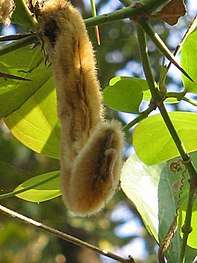Itching powder
Itching powder is a powder or powder-like substance that induces itching when applied onto human skin. This is usually done as a practical joke or prank to an unsuspecting victim.
The cause of the irritation can be mechanical, such as products containing ground rose hips.[1][2] Another common ingredient is Mucuna pruriens,[3] a type of legume that produces seedpods coated with thousands of detachable spicules (needle-like hairs), the spicules contain an enzyme (mucunain) that causes severe itching, and they have been sold commercially as itching powder.[4] Mucuna pruriens has been used to test the efficacy of anti-itch drugs.[3]
The term "itching powder" is colloquial; there is no one specific source of the powder, though some gag companies do tend to have favourites. Two very common, accessible, and fairly harmless (though not entirely – itching powder can be very dangerous when abused) sources are maple samara and rosehips. These are used in home recipes popularized by sites that publish how-to guides such as wikiHow and eHow. For the safety of the maker and of the victim, gloves (dust mask, and glasses as itching powder is a mouth and eye irritant) and caution are strongly encouraged whenever handling the processed powder. Rosehips contain prickly hairs that are used as the active ingredient,[5] whereas the body (rather than the wing) of the bigleaf maple samara is covered with spiny hairs that cause skin irritation,[6] and are used to make itching powder.[7][8]
Itching powder was created from mucuna pruriens in the early 19th century as a cure for lost feeling in the epidermis. When a person would lose feeling on their skin in conditions such as paralysis, the powder (mixed with lard to form an ointment) was used as a local stimulant believed to treat the condition.[9][10]
Gallery
 A mucuna pruriens seedpod. |
.jpg) The inside of a rose hip. Prickly hairs surround the seeds. |
.jpg) Bigleaf maple samara with spiny hairs. |
References
- Albert MR. Novelty shop "itching powder." Australasian J Dermatology. 1998 Aug;39(3):188–89.
- "Itching powder prank affects dozens of Cobb County students". FOX5Atlanta.com. Retrieved 15 July 2018.
- G.V. Joglekar, M.B. Bhide J.H. Balwani. An experimental method for screening antipruritic agents. British Journal of Dermatology. Volume 75 Issue 3 p. 117. March 1963
- "Epidemiologic Notes and Reports Mucuna pruriens- Associated Pruritus – New Jersey". Morbidity and Mortality Weekly Report (MMWR). Centers for Disease Control and Prevention. 6 December 1985. Retrieved 15 July 2018.
- Phytopharmacy: An Evidence-Based Guide to Herbal Medicinal Products. John Wiley & Sons. 27 April 2015. p. 324. ISBN 9781118543566.
- Hebda, R. "Plant profile: Acer macrophyllum" (PDF). NPSBC, menziesia. Native Plant Society of British Columbia. p. 14. Archived from the original (pdf) on 26 January 2007.
- "Itching Powder". MicrolabNW Photomicrograph Gallery. Retrieved 15 July 2018.
- "Maple Seed Hair". MicrolabNW Photomicrograph Gallery. Retrieved 15 July 2018.
- Blatin, M (1853). American Journal of Pharmacy and the Sciences Supporting Public Health, Volume 1; Volume 25. Philadelphia College of Pharmacy and Science. p. 471.
- Grieve, Maud (1 Jun 1971). A Modern Herbal: The Medicinal, Culinary, Cosmetic and Economic Properties, Cultivation and Folk-lore of Herbs, Grasses, Fungi, Shrubs, & Trees with All Their Modern Scientific Uses, Volume 1. Courier Corporation. p. 229. ISBN 9780486227986.
Watch for me by Moonlight by Evelyn Le Chene Corgi books ISBN 0 552 09673 3